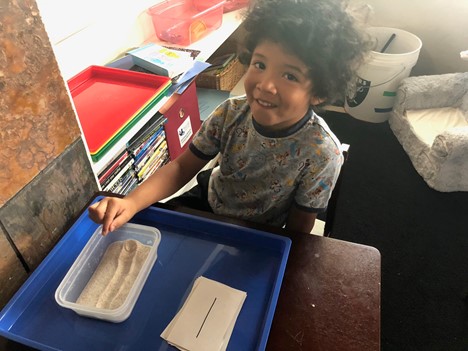
At School Mindset
- October 2, 2020
- Posted By : Sarah
- 0 Comment
-
The “At-School Mindset While Attending School at Home”
School is for education, but it is also for childcare so that parents can work.
We understand that parents have not had a break from parenting responsibilities since mid-March.
As much as online learning allows, we want to foster the culture of “at school”, with the goal being a time to cultivate independence and a true, uninterrupted work period for you and your child.
From the beginning of your child’s morning lesson to the end of their afternoon lesson, and for the time in between, they are “at school” and need to behave as such.
That means the teacher is the manager of your child’s time during that work period.
We will ease into this at the beginning of the year. First, we make it fun!
We Are Your Allies
Parents, you know your child better than anyone and we know that you want to help them be successful in this challenging model.
Here are some ways to help:
- Help your child to set up their workspace for the day
- Have all the necessary materials ready
- Once the day starts- “we are at school”, try and step away
We have entered the sixth month of the remote learning experience and we have found that:
- When the children are together with the teacher in the room (zoom) and the parent has stepped away, children are more engaged with the class:
- They become more talkative and more relaxed.
- They do not feel the “performance pressure” that occurs when mom or dad who they love and want to impress are there watching.
Of course, there are exceptions to this, again you really do know your child the best.
But please give it a try. Maybe move to the next room, out of sight, but within listening distance.
Here is what happens when you are right there, off the screen:
- Your child’s eyes reflexively flicker up to see you, off screen- looking for the answer, to check to see if you were watching, or that they are getting it “right”.
- When the child is participating in a more private space, they feel much more of a “school” vibe than they do when their parent is present, allowing them to participate more independently, without the natural pressure to please the parent.
- If you can step away, or be in the next room, that will help your child be “at school” and you can be “at work”.
Of course, they are not all alone in that private space, they are with their teacher and their classmates.
Know that – just like at school – your child may raise their hand to answer a question. They might not always get called on. This is ok and normal for school.
Working Up To It – “Being at School”
- Wouldn’t it be wonderful to have your child start their day “at school”, and you start your day “at work”?
- Then meet at noon for lunch.
- Realistically we all know that you can’t start there, but we can slowly get there by working at it.
Getting Started:
Provide enough distance to support your child’s engagement with the teacher but close enough to feel secure.
- At the start your child might prefer that you are sitting close by, quietly reading.
- Or your child might be totally confident alone with the door shut.
- It is different for each child. The speed at which that distance increases is different too. It is important to be patient.
From the start of the morning session to the end of the afternoon lesson, your child is “at school”.
The first step in helping your child be independent during school hours is to approach online school as though it is school, with similar structures and expectations. Here are some guidelines:
- We will arrive on time and be ready: dressed, have already had breakfast, and recently gone to the bathroom.
- We will greet each other and say hello.
- We will be kind to others.
- We will clean up each activity when we are done with it.
- We will take turns and listen when others are speaking.
- We will stay at the meeting and will follow the teacher’s instructions.
- If we need to leave the lesson/circle (i.e. bathroom break), we will say “Excuse me” and then tell the teacher.
The teacher will gently but firmly enforce these expectations. It is also understood that some children may have a hard time staying on screen. The teacher might instruct you to have your child sit off-screen, but nearby so they can still listen.

Intervening
Over the course of a typical school day:
- there are times the children are on the screen for live zoom calls and there are times in between where there is a recorded lesson to watch.
- It is recommended that you watch the video ahead of time.
- This will give you time to prepare any necessary materials.
- As you and your child create materials for the “work shelf” and the “work period” your child will begin to transition from the live call to their “work”.
In between the live zoom call, your child could be: (no screens)
- completing the assigned work from the morning’s zoom lesson,
- or something with the hands- art, building, drawing, writing, painting, sewing, working outside, nature explorations, definitely physical activity,
- but no screen time and no goofing off.
- We are still at school. The amount of screen time the children already have with us is way more than a three to five-year-old needs.
- Basically: have them participate in an activity that leads to concentration.
Helpful Language for Parents
“I’m bored, I don’t know what to do“
- It’s still school time. What is next on your list?
- Check your work shelf, you can go choose one you’d like to do, It’s still school time.
- Choose a quiet activity, maybe read some of your books, or take out coloring.
- Take out your activity, and I will meet you at (show them on the clock) to go outside for some play time.
- Remember, just like school, once the work period is over, you wash your hands, and we can set the table for lunch.
Here are some helpful words to guide your child to ask the teacher before they ask you:
- I see you have a question about school. Did you ask your teacher about it?
- I don’t know that answer. During school time, it’s best to ask your teacher before you ask mom or me.
- I remember that your teacher asked you to stay in your chair and ask her if you need anything. Did you ask her first? Let’s go back and try that.
- It’s school time. I’d be happy to talk to you about that when it’s not school time.
- It’s school time. I expect you to stay at your desk with your class, please.
- I’m glad to hear that you miss me and love me. We can still love each other even from different rooms. Please go back and finish your lesson with your class. Here’s a big hug to send you back.
At first, your child might be reluctant to come to zoom meetings. We have many enticing ways around this if you can at least get your child in the same room as the screen 🙂 It is our priority to make this fun. With young children, learning only really comes when it feels like play. We want your child to feel excited about coming to their lessons each day.
Remember: Patience is the Key
Taking classes online is challenging for adults, let alone young children. Try to set your expectations properly and understand that it will take your child time to adjust to this new learning environment and being frustrated or impatient with them or their teacher will not accelerate their adjustment time – it will do the opposite.
Be patient and your child will adjust over time, working together we can help maintain their progress until they come back to school in person.

